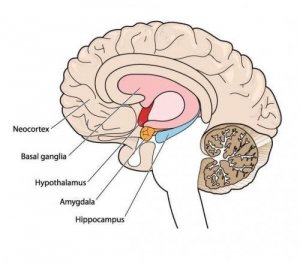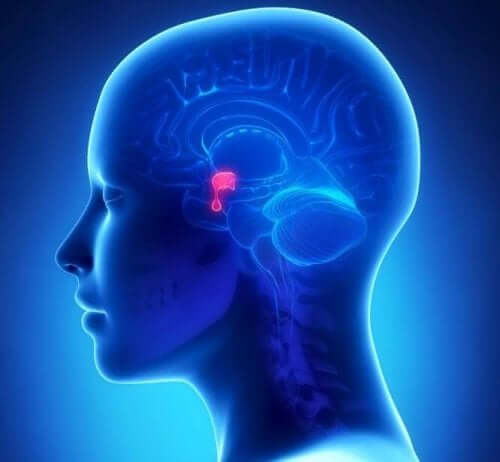Movement Disorders: Meet Athetosis

Athetosis is the set of involuntary slow and fluid contortions. This is one of the most common movement disorders, and it negatively impacts hands and feet. This condition is a rare manifestation of certain neurological diseases, especially those caused by anatomical and functional damage to the basal ganglia.
What are basal ganglia?
Basal ganglia are structures formed by gray matter. They’re found in the central portion of the brain. Their main characteristic is they have a large number of connections with other structures within the brain. Furthermore, they’re formed by the caudate nucleus, putamen, and pale globe.
These types of ganglia participate in the execution and maintenance of motor activity. Thus, anatomical and functional alterations due to deficit or excess of certain neurotransmitters show up in the form of abnormal movements.
Basal ganglia movement disorders

Most basal ganglia disorders have to do with functional disorders. This is due to a deficit or excess of certain neurotransmitters, which results in electrical hyperactivity in that region. Thus, these alter the motor activity of an affected person.
Overall, there are types of abnormal movements such as chorea, dystonia, tremors, and athetosis. Chorea consists of repetitive, brief and irregular involuntary movements. Such movements are sudden, to an extent, and begin in one part of the body, moving to another abruptly and unexpectedly, and often continuously. Generally, chorea affects the face, the mouth, the trunk, and the extremities. Hemiballismus is a type of chorea that usually involves violent involuntary spastic movements of an arm or a leg. The movements are wider and more intense than those from chorea.
Athetosis, like the other manifestations above, could be due to a large number of diseases. In addition, its presence often guides diagnosis. Chorea and athetosis, which can occur at the same time as choreoathetosis, aren’t exactly disorders. Instead, they’re symptoms produced by other various disorders.
Read also: How to Detect Autistic Spectrum Disorders
What is athetosis?

Overall, there are two types of movement disorders. Basically, they either correspond to a hypokinetic or hyperkinetic syndrome, depending on the type of motor activity involved.
- Hypokinetic syndrome includes Parkinson’s disease, neurodegenerative disorders, and secondary parkinsonism. It’s characteristic of these diseases to have their symptoms. However, these are typically due to medications or other organic causes. For instance, drugs, infectious diseases, trauma, and hydrocephalus.
- Hyperkinetic syndrome includes a series of obvious signs to those performing a physical examination. They include tremor, chorea, dystonia, tics, and myoclonus. What differentiates athetosis from other disorders is that patients are unable to keep some parts of their body in certain positions.
Athetosis manifests with slow, constant and inevitable movements. It usually occurs in the distal portions of the limbs, tongue, and throat, although it can happen anywhere else in the body. The slow movements characteristic of this disorder allow us to differentiate it from other alterations such as Chorea. However, there are similar clinical forms doctors refer to as “choreoathetosis.” The term “choreoathetosis” applies to various generative diseases such as Huntington’s disease.
You may also be interested: Everything You Need to Know About Cerebral Palsy
Movement disorders: other causes of athetosis
Also, there are other causes of athetosis, such as central nervous system infections like encephalitis. They’re related to the diffused and severe damage of all brain tissue. For this reason, movement disorder symptoms are quite common. Also, autoimmune disorders such as systemic lupus erythematosus can occur with this type of neurological alterations. However, it’s not the most typical presentation of the disease.
However, these patients should receive long-term treatment with immunosuppressants such as steroids. Consequently, there may be a tendency to nervous system infections. Also, it can trigger movement disorders, similar to what happens in encephalitis.
All cited sources were thoroughly reviewed by our team to ensure their quality, reliability, currency, and validity. The bibliography of this article was considered reliable and of academic or scientific accuracy.
- Delfino, L; Gauna, A. (2010). COREA AGUDA COMO PRESENTACIÓN DE LA ENFERMEDAD DE GRAVES. RAEM.
- Willshaw Z, M. E., Atria R, A., & Ferrer D, S. (2009). Hipertiroidismo y coreatetosis. Revista Chilena de Pediatría. https://doi.org/10.4067/s0370-41061986000600023
- Buriticá, O. (2004). Discinesias tardias 10. Asociación Colombiana de Neurología.
This text is provided for informational purposes only and does not replace consultation with a professional. If in doubt, consult your specialist.








